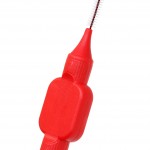
The effective removal of plaque is important for the prevention of both caries and periodontal disease. Interdental cleaning aids are frequently recommended in addition to toothbrushing to improve plaque removal. The aim of this study was to investigate interproximal plaque removal with an angled interdental brush as compared to a straight interdental brush.
Adults aged 20-65 with at least 15 natural teeth and good motor skills were recruited via newspaper adverts. The use of both brushes was demonstrated and then patients were randomised into either of the angled or straight interdental bush group. After a 12-day home-care habituation period, participants received a professional tooth cleaning followed by a 48-h plaque regrowth period. At the intervention appointment, plaque was recorded with a fluorescent revelator and soft tissue damage was noted (T0). Interdental brushing was performed by the participant for 2 min, and clinical parameters were recorded again. The primary end point was he difference in modified Proximal Plaque Index (mPPI) after brushing compared to baseline. Safety end point was the Danser gingival abrasion index (DI).
- 128 patients were randomised 64 to each arm. There were no dropouts.
- The mean difference before and after brushing of 1.09 (SD 0.20) for the angled brush and 1.59 (SD 0.28) for the straight brush. This was statistically different in favour of straight brushes (P < 0.0001)
- Brushing efficacy in posterior teeth, premolars and molars, using straight interdental brushes, was significantly higher (1.25, SD 0.23) as compared to angled interdental brushes (0.8,SD 0.28) (P < 0.0001)
The authors concluded
Straight interdental brushes may better remove plaque interproximally when compared to angled interdental brushes.
Comment
This study is of short duration, the effectiveness of the interdental brushing being evaluated over a single timed brushing session which does not reflect real life which needs to be taken into account. Currently an ongoing Cochrane review (Poklepovic et al) is seeking to evaluate the effectiveness of interdental brushing in addition to toothbrushing, as compared with toothbrushing alone or toothbrushing and flossing for the management (prevention) of both periodontal disease and caries.
A 2012 review by Imai et al included 7 trials comparing floss and interdental brushes for signs of periodontal disease and concluded that Interdental brushes were an effective alternative to dental floss for reducing bleeding and plaque between four and 12 weeks. An earlier review by Slot et al published in 2008 also suggested that Interdental brushes as an adjunct to brushing removed more dental plaque than brushing alone.
Links
Jordan R, Hong H, Lucaciu A, Zimmer S. Efficacy of straight versus angled interdental brushes on interproximal tooth cleaning: a randomized controlled trial. Int J Dent Hyg. 2013 Jul 24. doi: 10.1111/idh.12042. [Epub ahead of print] PubMed PMID: 23879344.
Poklepovic T, Sambunjak D, Johnson TM, Imai P, Tugwell P, Nickerson JW, Clarkson JE, Worthington HV. Interdental brushing for the management of periodontal diseases and dental caries in adults (Protocol). Cochrane Database of Systematic Reviews 2012, Issue 5. Art. No.: CD009857. DOI: 10.1002/14651858.CD009857.
Imai PH, Yu X, MacDonald D. Comparison of interdental brush to dental floss for reduction of clinical parameters of periodontal disease: a systematic review. Canadian Journal of Dental Hygiene.2012;46(1):63‐78.
Slot D E, Dorfer C E, Van der Weijden G A. The efficacy of interdental brushes on plaque and parameters of periodental inflammation: a systematic review. International Journal of Dental Hygiene.2008;6(4):253‐264.
